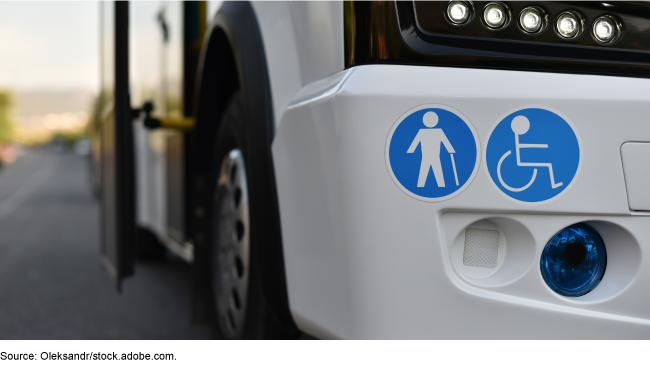Nonemergency Medical Transportation: Leading Practices Would Help the Federal Transit Administration Evaluate Its Pilot Program
Fast Facts
Millions of Americans rely on medical transportation services and public transport to get to routine medical care.
In 2015, the Federal Transit Administration began a pilot program to provide grants specifically for nonemergency transportation programs. We found weaknesses, such as no plan for evaluating whether the program is meeting goals.
The agency has 6 other programs that could fund nonemergency transportation. However, information about using the programs in this way isn't readily available for grant-seekers.
We recommended the agency provide this information and develop an evaluation plan.

Highlights
What GAO Found
Seven Federal Transit Administration (FTA) grant programs provide funding for general public transportation that may be used to support nonemergency medical transportation (NEMT) services. These funds may be used to purchase vehicles that provide transportation to medical appointments or fund call centers that schedules rides for health care, among other activities.
Examples of Nonemergency Medical Transportation (NEMT) Activities

Established in 2015, the Pilot Program for Innovative Coordinated Access and Mobility (ICAM) is the only FTA program that specifically mentions NEMT as part of its primary objectives. FTA established objectives for ICAM and ensured stakeholder communication but did not follow the other three leading practices for the effective design of pilot programs. FTA did not develop an assessment methodology, establish an evaluation plan, or develop criteria to assess whether ICAM is scalable, such as whether and how the pilot could be expanded. A comprehensive evaluation plan that includes an assessment methodology and criteria to assess scalability would help FTA determine whether ICAM is achieving its goals of increasing health care access and improving health outcomes. Such efforts could also provide Congress with information in making decisions about the future of ICAM, which is funded through fiscal year 2026.
Publicly available FTA information does not provide a holistic, readily accessible picture of how FTA funds can be used to support NEMT. While ICAM materials discuss NEMT, materials for the other six FTA grant programs that are eligible to support NEMT provide little to no information related to NEMT. Information that is provided is dispersed across multiple sources. Many of the 25 FTA grant recipients GAO interviewed thought it would be helpful to have consolidated or simplified information about using FTA programs for NEMT. In July 2024, FTA published a notice that it is establishing a national center that will promote NEMT coordination as part of its portfolio. However, since the center has not been established, whether it will provide resources about using FTA funding for NEMT services is unclear. Consolidating and publishing information on the potential uses of FTA funding to support NEMT could help potential applicants, recipients, and other stakeholders interested in initiating or expanding this key transportation service.
Why GAO Did This Study
Millions of Americans, particularly those requiring regular access to medical services, such as older adults or people with disabilities, rely on NEMT. A lack of access to NEMT can result in delayed care and poorer health outcomes. The Department of Transportation's FTA administers several programs that provide funding for public transportation, some of which may be used to support NEMT. House Report 117-402 included a provision for GAO to study FTA grant programs that could support NEMT.
This report evaluates (1) FTA's design and implementation of the ICAM program against leading practices for pilot programs and (2) how FTA communicates the availability and use of its funding for NEMT, among other objectives.
GAO reviewed FTA documentation on ICAM and compared FTA's efforts to leading practices for the effective design of pilot programs. GAO also reviewed the information FTA publicly shares about its funding programs. GAO interviewed FTA officials on ICAM and selected FTA grant recipients.
Recommendations
GAO is making two recommendations to FTA, to (1) develop an evaluation plan for ICAM, which includes an assessment methodology and scalability criteria and to (2) consolidate and publish information about using FTA funding for NEMT. DOT agreed with our recommendations.
Recommendations for Executive Action
| Agency Affected | Recommendation | Status |
|---|---|---|
| Federal Transit Administration | The Administrator of FTA should develop a plan to evaluate the Pilot Program for Innovative Coordinated Access and Mobility that includes an appropriate program assessment methodology and criteria to assess the scalability of the program. (Recommendation 1) |
When we confirm what actions the agency has taken in response to this recommendation, we will provide updated information.
|
| Federal Transit Administration | The Administrator of FTA should ensure that FTA consolidates and publishes information about using FTA funding for NEMT. This may include developing resources through the CCAM national technical assistance center that identify which FTA programs are relevant, provide examples of FTA-funded projects, and direct applicants, recipients, and other stakeholders to related NEMT resources using embedded links. (Recommendation 2) |
When we confirm what actions the agency has taken in response to this recommendation, we will provide updated information.
|
